The Samsung Galaxy S6 and S6 edge Review
by Joshua Ho on April 17, 2015 9:00 AM EST- Posted in
- Smartphones
- Samsung
- Mobile
- Galaxy S6
- Galaxy S6 Edge
System Performance
In order to test the Exynos 7420 and the phone in general, we turn to our suite of benchmarks which are able to show how the device performs in common general computing workloads. Something as simple as web browsing is still surprisingly intensive on mobile phones, and in general Android can often be quite stressful to run in the constraints of a ~3W total TDP especially on any phone still running Dalvik due to its strong reliance on bytecode and a virtual machine that translates bytecode to machine code just before and during application runtime. ART improves this significantly, but is limited in the nature of optimization as AOT compilation optimizations are limited by the CPU power of the SoC and the need to compile the application in a reasonable amount of time.
As always, we'll start things off with our browser benchmarks. After getting to use the phone, it became clear to me that Chrome is poorly optimized against the Galaxy S6 as Samsung’s browser is clearly superior in performance. For that reason I've gone ahead and run our benchmarks on both Chrome and on the stock browser, as seen below.

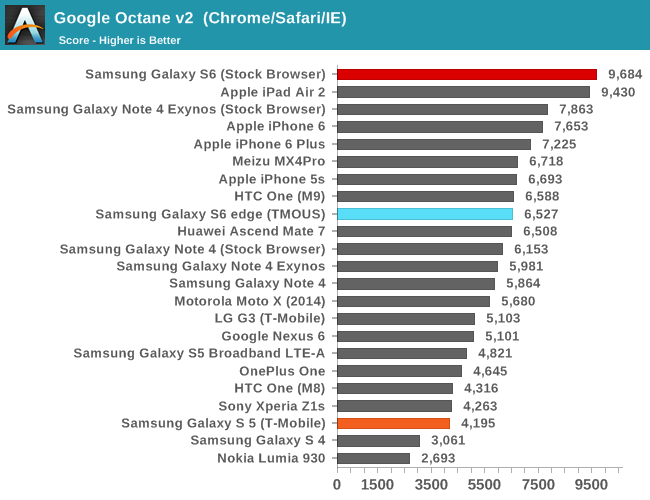

Needless to say, in order to see the full potential of the Exynos 7420 and its cluster of A57s, it’s necessary to use Samsung’s stock browser. This performance is really quite amazing when compared to Apple’s A8X, which has basically been the gold standard for performance in the mobile space in the context of ARM SoCs.
Moving on, as a part of our updates to the benchmark suite for 2015, we'll take a look at Basemark OS II 2.0, which should give a better picture of CPU performance in addition to overall device performance.
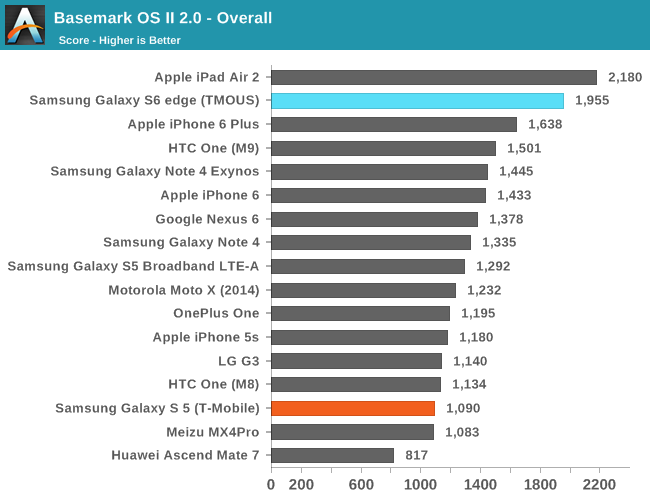
The browser benchmarks seem to hide some pretty enormous variability as the Galaxy S 6 edge (which is comparable to the Galaxy S 6) sets a new record among Android devices. The only challenger is the iPad Air 2, which uses the A8X SoC with three Enhanced Cyclone cores and the semi-custom GXA6850 GPU.
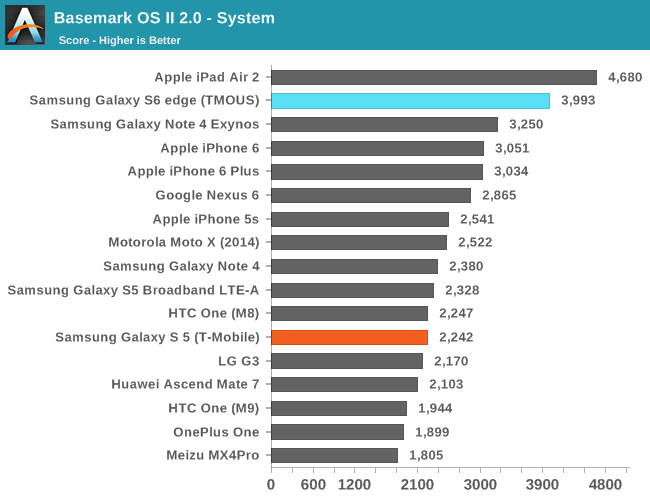
This system test contains a floating point and integer test, in addition XML parsing, which means that this test mostly stresses CPU and RAM. Interestingly enough, the Exynos 7420 pulls far ahead of both the Exynos 5433 and Snapdragon 810 in this test, and approaches the A8X. The difference between the 5433 and 7420 is likely a combination of the higher clocks on both the A57 and A53 clusters for the 7420 (1.9/1.3 on the 5433, 2.1/1.5 on the 7420), in addition to the ability to stay at a high 'overdrive' clock due to reduced leakage from the 14LPE process. The One M9 likely falls a bit short here due to HTC's governor settings restricting the use of all 8 cores simultaneously.

While one might guess that the memory test of 'Basemark OS II 2.0 - Memory' is of RAM, this is actually a test of the internal storage. Once again we see the S6 edge come close to leading the pack due to the use of the new UFS (Universal Flash Storage) standard. Casual examination reveals that the S6 edge has a queue depth of 16, and that it identifies itself with the rather cryptic model name of KLUBG4G1BD-E0B1.
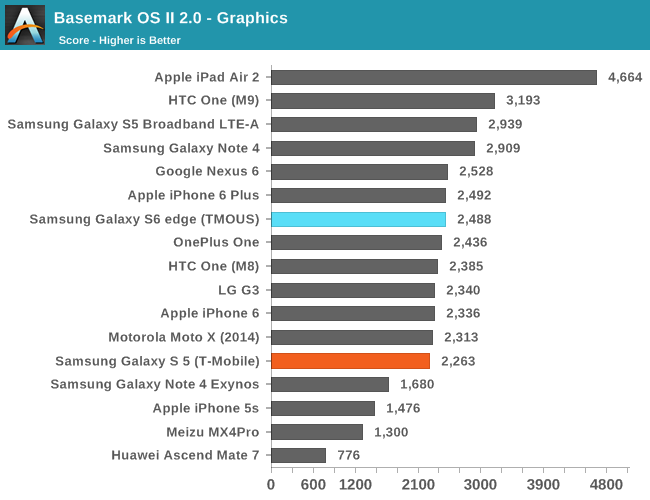
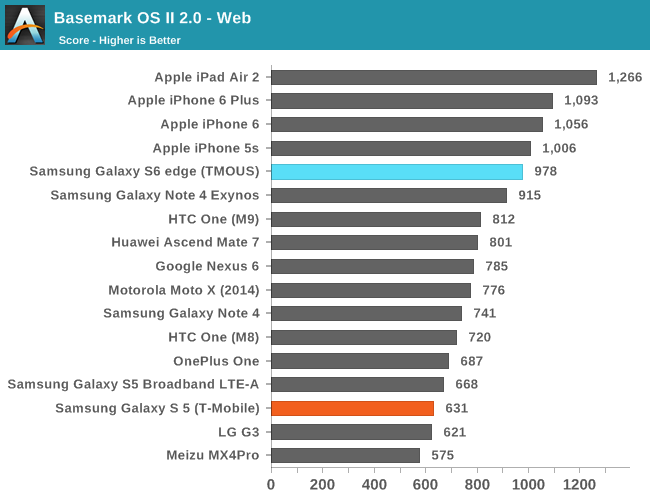
For the web test, it uses the built-in WebView rendering engine rather than Chrome and paints a distinctly different picture, especially because these tests are focused on HTML5 and CSS rather than JavaScript. Here we can see that the iPhone 6 and iPad Air 2 continue to hold their lead, but the Galaxy S6 is pretty much the king of the hill when it comes to Android devices.
Our next system benchmark is PCMark, which does a number of basic benchmarks designed to stress various aspects of the device in everyday workloads like video playback, web browsing, text editing, and photo editing. This tends to test every aspect of a mobile device, unlike microbenchmarks that can often miss aspects of the system that can affect performance.
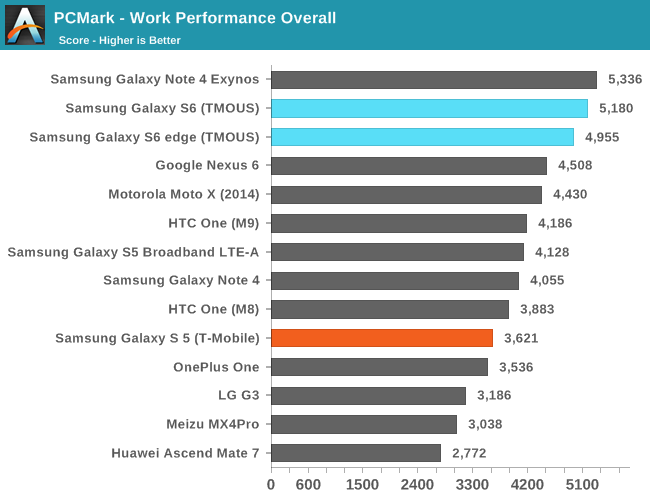
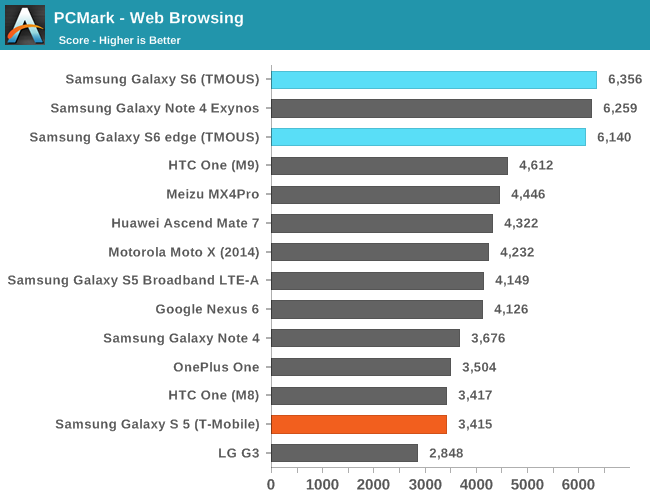
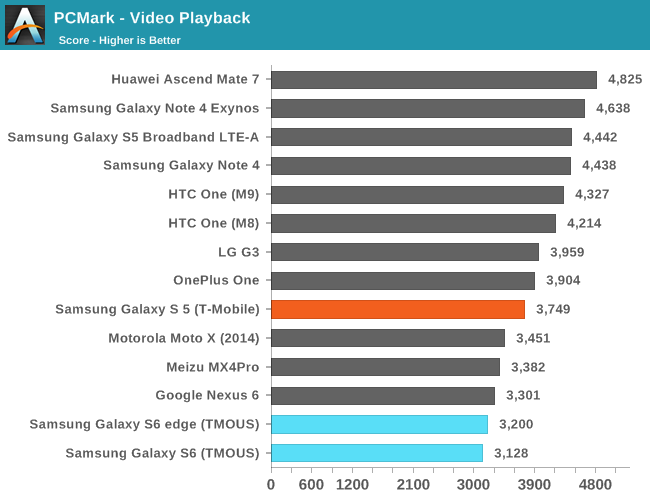
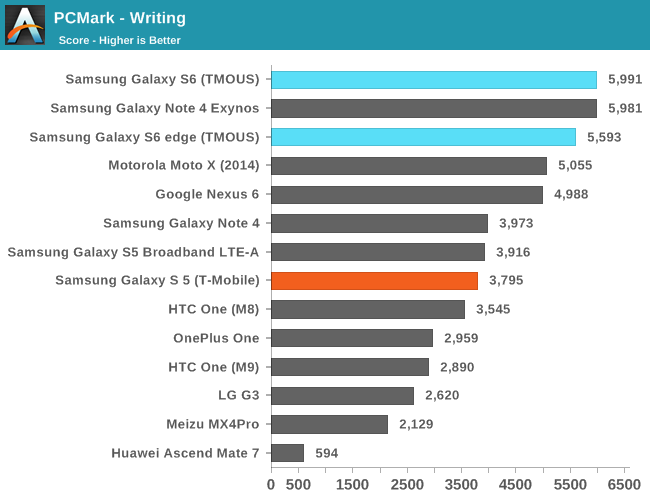

In these tests, the Galaxy S6 continues to perform strongly here due to the fast NAND storage solution and the Exynos 7420 SoC. As we have already covered the Basemark OS II 2.0 results in previous articles, I would refer back to it as those scores are final and have already been contextualized.
Overall, in these general purpose computing tasks that stress CPU, memory, and NAND performance we can see that the Exynos 7420 is off to a flying start. Samsung Mobile should focus more strongly on optimizing the software stack against Chrome as mobile Chrome has around twice the user share of stock Android browsers. I often say that the SoC is the foundation to a good smartphone, and in the case of the Galaxy S6 it feels like this is especially true.










306 Comments
View All Comments
Peichen - Saturday, April 18, 2015 - link
Just get the iPhone 6+ then. I typically get between 8-10 hours of screen-on time on my 6+ divided evenly between LTE and wi-fi. My record is 10hr 23min screen-on over 1day 14hr at 36% Safari, 16% Home screen and 10% Family Guy.GreenMeters - Friday, April 17, 2015 - link
Great, you idiot reviewers have ruined the last good phone easily available in North America. Can you form-over-function morons now leave the tech sites and go write for GQ or Cosmo or whatever? Then maybe in another phone generation or two without your horrible opinions clouding all the tech sites, we can once again get an awesome pocket computer instead of shiny garbage.gnx - Friday, April 17, 2015 - link
I feel for ya. I was pretty sure Samsung, always mindful of its home market South Korea and the preponderance of those Korean users needing swappable batteries there, would ensure removable battery (if not removable SD card) .... boy, was I wrong ...Drumsticks - Friday, April 17, 2015 - link
LG G4 should have removable and microSD.phoenix_rizzen - Friday, April 17, 2015 - link
Most likely it will depend on market, same as the LG G3 and LG G2 before it.Solandri - Friday, April 17, 2015 - link
Reviewer (male) says "there was zero benefit to the edge display". Try carrying your phone around in a purse, and you will see a huge benefit to the edge display - checking notifications and seeing who is calling without having to pull the phone out of your purse.LifesABeta - Friday, April 17, 2015 - link
Nice that you guys were at my university(UCLA) to conduct these tests :DRyan Smith - Friday, April 17, 2015 - link
It's a good place. We leave Josh in their care when he isn't writing fantastic phone reviews for us. =Phalcyonmax - Friday, April 17, 2015 - link
Samsung has come out with a well rounded device this year.Good design,good hardware and acceptable software.Personally i'm impressed with samsung's cutting edge SoC .The exynos 7420 is by far the best SoC out there,clearly ahead of the snapdragon 810.The exynos maintains higher clock speeds over extended workloads while keeping power consumption and temperature in check.The GPU does lag behind in the on screen performance but that has to to do with the 2560x1440 resolution.
Samsung's innovation would have been much more prominent if they had kept the screen resolution down.
The lack of sd card and removable battery support are those aspects of the device which have the potential of making it or breaking it for a number of consumers.Personally i have no issues with a non removable battery since i'm a casual user however for hardcore gamers or power users who charge their devices at least twice a day,they inevitably would have to face the hardship of getting their device's battery replaced at some point after about a year's usage.I'm acceptant of samsung's decision to do without the sd-slot.It could be a serious let down for some but after the restriction of kitkat 4.4( for security reasons) its just difficult to move data to the sd card.My last two sd cards got corrupted and i have lost my data on sd card more than once(maybe just my carelessness).I'm happy samsung are providing wider storage options for consumers with varying storage needs.
After the disappointments of my previous samsung devices i've stayed away from anything samsung, however i'm looking forward to getting this device.
phoenix_rizzen - Friday, April 17, 2015 - link
The S6 is roughly 2 mm thinner than the S5 and yet the camera sticks out ... roughly 2 mm? Would it have been so hard to made the phone the same thickness as the S5 and make the camera flush with the body? That would also have added some extra internal volume to keep the battery closer to the size of the S5's.Another case of pointless "thinness" spec whoring. :(